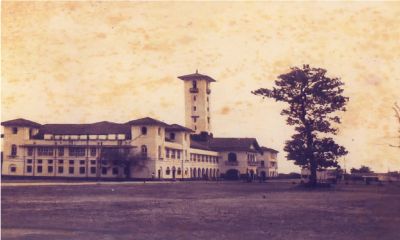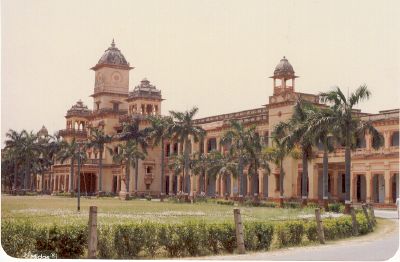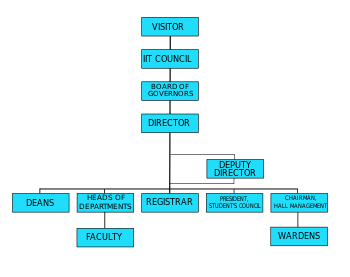Indian Institutes Of Technology
 From Nwe
From Nwe The Indian Institutes of Technology (IITs), constitute an elite group of autonomous engineering and technology-oriented institutes of higher education established and declared as Institutes of National Importance. The Government of India created the IITs to train scientists and engineers, with the aim of developing a skilled workforce to support the economic and social development of India after independence in 1947. Indians colloquially refer to the students and alumni of IITs as IITians.
IIT has combined an excellent plan to create a world class science and technology college education program with a successful implimentation of that plan to create one of the world's best technology programs. India has faced an enormous challege to establish a Republic of India in the aftermath of British colonial rule. Critical to the success of establishing a republic has been the development of India's economy to compete with the leading science and technology nations, including the European Union, the United States, and Japan. ITT has performed a vital task in raising India to one of the top technology producing nations in the world.
Overview
The first seven IIT campuses, in order of establishment, are located in Kharagpur, Mumbai (Bombay), Chennai (Madras), Kanpur, Delhi, Guwahati, and Roorkee. UNESCO, Germany, the United States, and the Soviet Union provided financial assistance and technical expertise to establish some IITs. Each IIT acts as an autonomous university, linked to the others through a common IIT Council, which oversees their administration. They have a common admission process for undergraduate admissions, using the Joint Entrance Examination (popularly known as IIT-JEE) to select around 4,000 undergraduate candidates a year. Postgraduate Admissions proceed on the basis of the GATE and CEED.
IITians have achieved success in a variety of professions, resulting in the establishment of the widely recognized Brand IIT.[1] The autonomy of the IITs has helped them to create specialized degrees in technology at the undergraduate level, and consequently to award the Bachelor of Technology (B.Tech.) degree, as opposed to the Bachelor of Engineering (BE) degree awarded by most other Indian universities. The success of the IITs has led to the creation of similar institutes in other fields, such as the National Institutes of Technology, the Indian Institutes of Management and the Institutes of Information Technology (IIT).
The Institutes

The first seven IITs have campuses in Kharagpur, Bombay, Madras, Kanpur, Delhi, Guwahati, and Roorkee. An additional 16 IITs have been established throughout India, bringing the total number of institutes to 23. All IITs act as autonomous universities that draft their own curricula.
The Indian government established the first IIT in 1951, in Kharagpur (near Kolkata) in the state of West Bengal. With 29 academic departments, centers and schools, spread over a 8.5 km² (2,100 acre) campus constitutes a self-contained township of over 15,000 inhabitants. Approximately 450 faculty, 2200 employees, 3000 undergraduates and 2,500 postgraduates live and work on the campus. The students live in seventeen hostels (called Halls of Residence). IIT Kharagpur also has a medical technology school (School of Medical Science and Technology), a management school (Vinod Gupta School of Management) and a law school (Rajiv Gandhi School of Intellectual Property Law) within its premises.
The second IIT, IIT Bombay, founded in 1958 in Powai, Mumbai (Bombay) had been established with assistance from UNESCO and the Soviet Union, which provided technical expertise. The Indian government underwrote all other expenses, including the construction costs. With an area of 2.23 km² (550 acres) and a total of 24 departments, centers and schools, IIT Bombay represents the largest university in the state of Maharashtra. In addition, IIT Bombay has 13 student hostels with about 2200 undergraduate and 2000 postgraduate students. IIT Bombay also has schools in management (Shailesh J. Mehta School of Management) and information technology (Kanwal Rekhi School of Information Technology) on its premises. Despite a change in the name of the city, the IIT retains the original name.
IIT Madras,[2] located in the city of Chennai in Tamil Nadu, was established in 1959 with technical assistance from the Government of West Germany. The campus spreads over an area of about 2.5 km² (620 acres), with 15 academic departments, nearly 100 laboratories, and 14 hostels. As with IIT Bombay, it retains its original name despite a change in the name of its city.
IIT Kanpur, established in 1959 in the city of Kanpur, Uttar Pradesh, benefited during its first ten years from the Kanpur–Indo-American Programme, where a consortium of nine US universities helped to set up the research laboratories and academic programs.[3]
Established as the College of Engineering in 1961, IIT Delhi received the current name and declared an Institution of National Importance under the "Institutes of Technology (Amendment) Act, 1963." Located in Hauz Khas (New Delhi), with an area of 1.3 km² (320 acres), the college has 11 hostels and 26 departments, centers and schools.
IIT Guwahati, established in 1994 near the city of Guwahati (Assam) on the northern banks of the Brahmaputra River, has a sprawling 2.85 km² (705 acres) campus that attracts many visitors because of its scenic beauty.[4]
IIT Roorkee, originally known as the University of Roorkee, had been established by the Viceroy of India in 1847 as the first engineering college of the British Empire. Located in Uttarakhand, the college received a new name, The Thomason College of Civil Engineering, in 1854. The newly establish Indian government renamed the college in 1949 "University of Roorkee." The University of Roorkee joined the IIT system in 2001 as IIT-Roorkee. The institute offers undergraduate degree courses in ten disciplines of engineering and architecture, and postgraduate degrees in fifty-five disciplines, with a faculty of 375 members. The campus covers 1.45 km² (360 acres) and has nine hostels, including the Department of Management Studies (DOMS), offering MBA courses.
History
The history of the IIT system dates back to 1946 when Sir Jogendra Singh of the Viceroy's Executive Council set up a committee with the task of considering the creation of Higher Technical Institutions for post-war industrial development in India. The twenty-two member committee, headed by Nalini Ranjan Sarkar, recommended the establishment of those institutions in various parts of India, with affiliated secondary institutions. The committee felt that such institutes should produce, along with undergraduates, researchers and academics. The governments expected the institutes to maintain high educational standards.
With those recommendations in view, the government founded the first Indian Institute of Technology in May 1950 at the site of the Hijli Detention Camp in Kharagpur. On September 15 1956, the Parliament of India passed the Indian Institute of Technology (Kharagpur) Act, declaring it as an Institute of National Importance. Jawaharlal Nehru, first Prime Minister of India, in the first convocation address of IIT Kharagpur in 1956 said:[5]
| “ | Here in the place of that Hijli Detention Camp stands the fine monument of India, representing India's urges, India's future in the making. This picture seems to me symbolical of the changes that are coming to India. | ” |
On the recommendations of the Sarkar Committee, the government established four campuses at Mumbai (1958), Chennai (1959), Kanpur (1959), and Delhi (1961). The government chose the locations of the campuses scattered throughout India to prevent regional imbalance. The Indian Institutes of Technology Act was amended to reflect the addition of new IITs.[6] Student agitations in the state of Assam made Prime Minister Rajiv Gandhi promise the creation of a new IIT in Assam. That led to a sixth campus at Guwahati under the Assam Accord in 1994. The University of Roorkee, India's oldest engineering college, received IIT status in 2001.
Over the past few years, a number of developments toward establishing new IITs have appeared. On October 1 2003, Prime Minister Atal Bihari Vajpayee announced plans to create more IITs "by upgrading existing academic institutions that have the necessary promise and potential."[7] Subsequent developments led to the formation of the S K Joshi Committee in November 2003 to guide the selection of the five institutions which would become the five new IITs.
Based on the initial recommendations of the Sarkar Committee, the government decided that additional IITs should be established throughout the country. When the government expressed its willingness to correct that regional imbalance, sixteen states demanded IITs. Since the S K Joshi Committee prescribed strict guidelines for institutions aspiring to be IITs,[8] only seven colleges were selected for final consideration.[9]
Organizational structure
The President of India stands as the most powerful person in the organizational structure of IITs, being the ex officio Visitor and having residual powers. Directly under the President sits the IIT Council, which comprises the minister-in-charge of technical education in the Union Government, the Chairmen of all IITs, the Directors of all IITs, the Chairman of the University Grants Commission, the Director General of CSIR, the Chairman of IISc, the Director of IISc, three members of Parliament, the Joint Council Secretary of Ministry of Human Resource and Development, and three appointees each of the Union Government, AICTE, and the Visitor.[10]
Under the IIT Council stands the Board of Governors of each IIT. Under the Board of Governors serves the Director, the chief academic and executive officer of the IIT. Under the Director, in the organizational structure, comes the Deputy Director. Under the Director and the Deputy Director, come the Deans, Heads of Departments, Registrar, President of the Students' Council, and Chairman of the Hall Management Committee. The Registrar serves as the chief administrative officer of the IIT and overviews the day-to-day operations. Below the Heads of Department (HOD) stand the faculty members (Professors, Associate Professors, and Assistant Professors).
Admission
Students gain admission to undergraduate B.Tech and integrated M.Tech programs through IIT-JEE (the Joint Entrance Examination) in which approximately 300,000 students appear annually out of which only 5,000 win a seat. The colleges grant admission to most postgraduate courses in IITs through various written entrance examinations. Admission to M.S. by way of through GATE and Ph.D. program primarily based on a personal interview, though candidates may also have to appear for written tests. The IITs have earned renown for their special reservation policy, which stands out in contrast with the rest of India.
Entrance examinations
Admission to undergraduate programs in all IITs depends on scores in the Joint Entrance Examination, popularly known as IIT-JEE. Candidates who qualify admission via IIT-JEE can apply for admission in B.Tech. (Bachelor of Technology), Dual Degree (Integrated Bachelor of Technology and Master of Technology) and Integrated M.Sc. (Master of Sciences) courses in IITs. IIT-JEE, a science-oriented entrance exam, tests candidate's knowledge of mathematics, physics and chemistry, conducted by an IIT chosen by a policy of rotation. Given the huge population of India, the undergraduate acceptance rate through JEE has a low ratio, around 1 in 55.[11] Only students who have completed (or will complete at the end of the current academic session) their higher secondary studies from a recognized educational board may sit for IIT-JEE. The IIT-JEE has earned a reputation for frequently changing the types of questions asked to discourage study by rote. Since IIT-JEE 2006, the format of the question paper changed to a single objective test-based paper, replacing the earlier system that employed two tests. An upper age limit for appearing for the IIT-JEE has been set at 25 years old. Students select their institute and department of study based on availability at the time of their counseling and interview that follows the IIT-JEE result. The interviews usually spread over five days.
Students gain admissions into the postgraduate programmes primarily the Graduate Aptitude Test in Engineering (GATE) for M.Tech and some MS programs. That exam, one of the most difficult in the country, tests the conceptual clarity in technical subjects. Other prominent entrance exams include JAM (Joint Admission to M.Sc.) for M.Sc., and JMET (Joint Management Entrance Test) for Management Studies.
Reservation policy
India practices a form of affirmative action (known by critics as reverse discrimination) on caste-based reserved quotas. As per the provisions in the Indian constitution, the IITs have been reserving seats for Scheduled Castes of society since 1973. The IITs follow a reservation policy notably different from the quota policy elsewhere in India. As per the rules, all the Scheduled Caste (SC) and Scheduled Tribe (ST) candidates must take the IIT-JEE with the rest of the students.
Another group of candidates who fail to meet that relaxed admission criteria receive offers of a "Preparatory Course" comprising of English, Physics, Chemistry and Mathematics at the IIT concerned. After one year of study, those candidates who secure a grade higher than the prescribed cut-off mark during end-of-semester exams may continue regular studies. All students must meet criteria for passing the exams or graduating a course. The candidates admitted through the reservation policy face the criteria as the general candidates for graduation.
In 1989, Prime Minister V. P. Singh accepted and implemented the proposals of the Mandal Commission that recommended provisions of reservations for OBCs in private unaided institutions as well as high-end government jobs for minority communities. No changes took place in the IITs because of the legislation, but in 2005, based on the recommendations of a political panel, the UPA government proposed to implement the reserved-quota system for the OBCs in IITs and IIMs. It received critical objections by many scholars and critics, who described the proposal as "dangerous and divisive" and based solely on political (vote-bank) purposes. Many argued that the OBCs constitutes a competitive community, enjoying good economic and social status and thus a reservation for OBCs becomes a mere strategy to gain votes. When the government planned to implement the quota system, anti-reservation protests erupted throughout India against the proposal. Student agitations also took place in the IITs, with many students opposed caste-based reservations resorting to hunger strikes. They labeled the quota system as a government tactic to earn cheap votes, creating a system would lead to increased casteism and a severe compromise on merit and talent.
The additional procedures for admission into the IITs (the preparatory course and the qualifying end-of-semester exams that follow) have also been criticized as unnecessary and counter-productive. An argument opposing the modified policy of reservation and favoring direct admission points to a large number of seats remain vacant under the present scheme.[12]
Education

The IITs receive disproportionately high number of grants compared to other engineering colleges in India.[9] Other sources of funds include student fees and research funding from industry. That has translated into superior infrastructure and better faculty in the IITs and consequently higher competition among students to gain admissions into the IITs. The faculty-to-student ratio in the IITs is between 1:6 and 1:8. The Standing Committee of IIT Council (SCIC) prescribes the lower limit for faculty-to-student ratio as 1:9, applied department wise. The IITs subsidize undergraduate student fees by approximately 80 percent and provide scholarships to all Master of Technology students and Research Scholars to encourage students for higher studies, per the recommendations of the Thacker Committee (1959–1961).
The various IITs function autonomously, and their special status as Institutes of National Importance facilitates the smooth running of IITs, virtually free from both regional as well as student politics. Such autonomy means that IITs can create their own curricula and adapt rapidly to the changes in educational requirements, free from bureaucratic hurdles. The government lacks direct control over internal policy decisions of IITs (like faculty recruitment and curricula) but has representation on the IIT Council. All IITs use only English for course work. All the IITs have libraries for the use of their students. In addition to a collection of prescribed books, the libraries have sections for fiction and other literary genres. The electronic libraries allow students to access on-line journals and periodicals.
Each IIT has a Senate, comprised of all professors of the IIT and student representatives, that decides academic policies. Unlike many western universities that have an elected senate, the IITs have an academic senate that controls and approves the curriculum, courses, examinations and results, as well as appointing committees to look into specific academic matters. The Senate periodically reviews the teaching, training and research activities of the institute to maintain educational standards. The Director of an IIT is the ex-officio Chairman of the Senate.
All the IITs follow the credits system of performance evaluation, with proportional weighting of courses based on their importance. The total marks (usually out of 100) form the basis of grades, with a grade value (out of ten) assigned to a range of marks. Sometimes, professors use relative grading considering the overall performance of the whole class. For each semester, students receive grades on a scale of 0 to 10 based on their performance, by taking a weighted average of the grade points from all the courses, with their respective credit points. Each semester, students receive an evaluation, which combines as a weighted average with all semesters used to calculate the cumulative grade point average (known as CGPA or CPI—Cumulative Performance Index).
Undergraduate education
The B.Tech. degree constitutes the most common undergraduate degree in the IITs in terms of student enrollment, although the colleges also offer Dual Degrees and Integrated (five-year) Master of Science degrees. The B.Tech course has a four-year program with eight semesters, while the Dual Degree course follows a 5-year program with ten semesters. In all IITs, all the students follow a common course structure for the first year of B.Tech. and Dual Degree programs, though some IITs include a single department introduction related course. The common courses include the basics from most of the departments like Electronics, Mechanics, Chemistry, and Physics. At the end of first year (the end of first semester at IIT Madras), students who have performed with merit during the first two semesters receive an option to change departments. Few such changes ultimately take place due to the unusually strict criteria, limited to the most meritorious students.
From the second year onwards, the students study subjects exclusively in their respective departments. In addition to those, the students have to take compulsory advanced courses from other departments to broaden their education. Students must take compulsory courses from humanities and social sciences department, and sometimes management courses. At the end of third year, the undergraduate students have to undertake a summer project at an industry or reputed academic institute as part of the curriculum. In the last year of their studies, most of the students find internships in industries and organizations via the placement process of the respective IIT, though some students opt out of that either when going for higher studies or when they take up jobs by applying to the companies directly.
Postgraduate and doctoral education
The IITs offer a number of postgraduate programs including Master of Technology (M.Tech.), Master of Business Administration (MBA) (only for engineers and post graduates in science), and Master of Science (M.Sc.). Some IITs offer specialized graduate programmes such as the Post Graduate Diploma in Information Technology (PGDIT), Master in Medical Science and Technology (MMST), Master of City Planning (MCP), Postgraduate Diploma in Intellectual Property Law (PGDIPL), Master of Design (M.Des), and the Postgraduate Diploma in Maritime Operation & Management (PGDMOM). The IITs also offer the Doctor of Philosophy degree (Ph.D.) as part of their doctoral education programme in which candidates receive a topic of academic interest from the professor or work on a consultancy project given by the industries. The program usually has an unspecified duration, depending on the specific discipline. Ph.D. candidates have to submit a dissertation as well as provide an oral defense for their thesis. They often acceptTeaching Assistantships (TA) and Research Assistantships (RA). Some of the IITs offer an M.S. (by research) program; the M.Tech. and M.S. bare similarity to the US universities' non-thesis (course based) and thesis (research based) masters programs respectively. The IITs, along with NITs and IISc, account for nearly 80 percent of all PhDs in engineering.
The IITs also offer an unconventional B.Tech. and M.Tech. integrated educational program called "Dual Degree." Integrating undergraduate and postgraduate studies in selected areas of specialization, students complete the program in five years as against six years in conventional B.Tech. (four years) followed by an M.Tech. (two years). The program permits IITians to complete postgraduate studies from IIT rather than having to go to another institute.
Culture and student life
All the IITs provide on-campus residential facilities to the students, research scholars and faculty. The students live in hostels (sometimes referred to as halls) throughout their stay in the IIT. Students in all IITs must choose between National Cadet Corps (NCC), National Service Scheme (NSS) and National Sports Organisation (NSO) in their first years. All the IITs have sports grounds for cricket, football(soccer), hockey, volleyball, lawn tennis, badminton, and athletics; and swimming pools for aquatic events. Usually the hostels also have their own sports grounds.
Technical and cultural festivals
All IITs organize annual technical festivals, typically lasting three or four days, mostly held in the months of February or March. For example, the annual science and technology festival, Techfest IIT Bombay, which originated in 1998 to provide a platform for the Indian student community to develop and showcase their technical prowess, has grown into Asia's Largest Science and Technology Festival. The IITs also organize annual cultural festivals lasting three to four days.
In addition to those cultural festivals, IIT Kharagpur and IIT Bombay celebrate unique festivals. IIT Kharagpur celebrates the Illumination festival on the eve of Diwali. Students post large bamboo structures (called chatais) as high as 6 metres (20 feet), placing earthen lamps (diyas) on them to form outlines of people, monuments, or an event. Although mainly competition between hostels, colleges receive entries by outside visitors. The Rangoli festival couples with the Illumination festival. In Rangoli, fine powder, and sometimes even by crushed bangles made on the ground, create large panels showing an event or a concept.
The Performing Arts Festival (popularly known as PAF) refers to a festival unique to IIT Bombay. Technically a drama, each PAF includes drama, literature, music, fine arts, debating, and dance, held in the Open Air Theater (OAT) on the main campus of IIT Bombay. Typically two or three hostels (of fourteen) group together by random draw for each PAF. Performers deliver all dialogues as voice overs, mainly due to the structure and the huge size of the OAT.
Inter-IIT sports meet
The IITs compete among themselves in a number of sports events held under the aegis of the Annual Inter-IIT Sports Meet. Started in 1961, the competition runs every December at an IIT chosen by rotation. The award consists of a running shield passed over annually to the winning IIT. The weighted sum of the points earned in various events held over a period of five days determines the winners. Men and women compete separately with points tallied separately to determine the final winner of the General Championship.
The 12 events in the Inter-IIT Sports include athletics, badminton, basketball, cricket, football, hockey, swimming, lawn and squash tennis, table tennis, volleyball, water polo and weightlifting. Athletes compete in outdoor swimming and water polo, due to winter weather, in the first week of October, calling the competition Inter-IIT Aquatics Meet.
Recognition
The All India Council for Technical Education (AICTE) and hence all institutions in India, recognize IITs degrees. Even outside India, IIT degrees have earned respect, largely due to the prestige of alumnae. IITs special status as Institutes of National Importance under the Indian Institute of Technology Act ensures that the IITs have special privileges and lays the foundation for them to evolve as world-class institutes. The autonomy ensured by the Act enables the IITs to implement changes quickly, to keep up with changing scenarios in both the educational world, and society in general. Strict vigilance over student body elections has kept student politics under control. The IIT-JEE constitutes another important factor behind the success of IITs, enabling the IITs to accept only a select group of meritorious students. That combination of success factors has led to the concept of the IIT Brand.[13] Other factors that have contributed to the success of IITs include stringent faculty recruitment procedures and industry collaboration. The strict procedure for selection of faculty in IITs surpasses other colleges offering similar degrees. All regular faculty appointments must have a Ph.D. degree. The IITs have better interaction with various industries as compared to most other Indian colleges. A number of educational surveys indicate that IITs have earned a reputation as a highly successful institutions compared to other engineering colleges in India.
The view of IIT graduates as intelligent and hardworking people has been established by the success of IITians. Former IIT students tend to get greater respect from their peers, academia and industry in general. The IIT brand earned international recognition when the United States House of Representatives passed a resolution honoring Indian Americans, and especially graduates of IIT, for their contributions to the American society.[1] Similarly, China also recognized the value of IITs and planned to replicate the model.[14]
Educational rankings
Most IITs consistently rank above other engineering colleges in India in engineering education surveys, with regard to quality of faculty, teaching standards, research facilities and campus placements. In international surveys, the IITs fail to achieve top rankings. The Times Higher Education Supplement (2006) ranked the IITs the 57th best overall universities in their World University Rankings and gave IITs the 33rd position globally for science. The IITs received the third-best worldwide for technology, after MIT and University of California, Berkeley. In the Shanghai Jiao Tong University's Academic Ranking of World Universities, only one IIT (IIT Kharagpur) made the list for the top 500 universities worldwide. In another criterion, the Social Science Citation Index, the rank of IITs suffers as they have small departments of liberal arts and social sciences. As the IITs have only a few international faculty and students (except those by exchange programs), the rankings of IITs in many international surveys have suffered. IITs better scores than other Indian colleges and universities in educational ranking criteria put the colleges in top positions in nationwide surveys.
Criticism
The IITs have faced criticism from within and outside academia. Major concerns include allegations that they encourage a brain drain and that their stringent entrance examinations encourage coaching colleges and skew the socio-economic profile of the student body. Other critics express concern at the insufficient representation of women and the disadvantaged.
Brain drain
Sharpest criticism among the media, academia and the people in general, comes from the charge that IITs encourage brain drain. Until the process of liberalization started in early 1990s, India failed to provide good job opportunities to the graduates of IITs. That resulted in large scale emigration of IITians to western countries, especially to the United States. Since 1953, nearly 25 thousand IITians have settled in the USA.[15] Since the USA benefited from subsidized education in IITs at the cost of Indian taxpayers' money, critics consider subsidizing education in IITs useless. Others support the emigration of graduates, arguing that the capital sent home by the IITians has been a major source of the expansion of foreign exchange reserves for India, which, until the 1990s, had a substantial trade deficit.
The extent of intellectual loss has receded substantially. The liberalization of the Indian economy, and the opening of previously closed markets, have been credited with the reverse. Government initiatives have been encouraging IIT students to enter entrepreneurship programs while increasing foreign investment. Emerging scientific and manufacturing industries, and outsourcing of technical jobs from North America and Western Europe, have created opportunities for aspiring graduates in India. Many undergraduates go abroad to pursue further studies, such as the Master of Science degree and Ph.D.
Entrance competition
The highly competitive examination in the form of IIT-JEE has led to establishment of a large number of coaching institutes throughout the country that provide intensive, and specific preparation for the IIT-JEE for substantial fees. Some argue that favors students from specific regions and richer backgrounds. According to some estimates, nearly 95 percent of all students who clear the IIT-JEE had joined coaching classes.[16] The psychological stress and emotional trauma faced by candidates unable to pass the examination and their families has been considered a serious problem, leading to criticism of the examinations altogether. That led to a restructuring of the IIT-JEE format restructured in 2006.
After the change to the objective pattern of questioning, even the students who initially considered themselves unfit for subjective pattern of IIT-JEE decided to take the examination. Though the restructuring intended to reduce the dependence of students on coaching classes, it led to an increase in students registering for coaching classes. Some people (mostly IITians) have criticized the changed pattern of the IIT-JEE. They reason that, while IIT-JEE traditionally tested students understanding of fundamentals and their ability to apply them to solve large unseen problems, the current pattern diminished stress on the application part.
Alumni
The IITians have a reputation for their loyalty to their alma mater with many active IIT Alumni Associations in India and abroad. The IIT alumni either help their alma mater in the form of donations, or by preferential job opportunities extended to students from the IITs. Alumni donations have largely established the Vinod Gupta School of Management at IIT Kharagpur and Shailesh J. Mehta School of Management at IIT Bombay management schools; those schools took the names of their benefactors.
Many IIT alumni have become entrepreneurs, including N.R. Narayana Murthy (co-founder and chairman of Infosys), Vinod Khosla (co-founder, Sun Microsystems), and Suhas S. Patil (founder and Chairman Emeritus Cirrus Logic Inc.) Other alumni have achieved leading positions in corporations, such as Rajat Gupta (former Managing Director, McKinsey), Arun Sarin (CEO, Vodafone), Victor Menezes (Senior Vice Chairman, Citigroup), and Kanwal Rekhi (CTO, Novell). IIT alumni have also pursued careers in politics: for example, Manohar Parrikar became the Chief Minister of Goa. Many alumni have gained national and international recognition: Sushantha Kumar Bhattacharyya received the CBE, a knighthood, and Padma Bhushan; and V. C. Kulandaiswamy received the Padma Shri and Padma Bhushan awards. Narendra Karmarkar earned world-renowned for his work in applied mathematics.
Notes
- ↑ 1.0 1.1 H.Res.227 — Recognizing and honoring the contributions of Indian Americans to economic innovation and society generally, 109th Congress (2005-2006) Congress.gov. Retrieved October 11, 2021.
- ↑ ITT Madras. Retrieved October 11, 2021.
- ↑ IITK History. IIT Kanpur. Retrieved October 11, 2021.
- ↑ About us IIT Guwahati. Retrieved October 11, 2021.
- ↑ Carol Lobo, India's First IIT Started Life in a Prison Camp Live History India, July 1, 2021. Retrieved October 15, 2021.
- ↑ The Institutes of Technology Act, 1961 Retrieved October 15, 2021.
- ↑ Yogesh K. Upadhyaya, The making of new IITs Rediff, March 23, 2005. Retrieved October 15, 2021.
- ↑ Yogesh K. Upadhyaya, The march of the new IITs Rediff, August 18, 2005. Retrieved October 15, 2021.
- ↑ 9.0 9.1 Yogesh K. Upadhyaya, New IITs: A long journey ahead Rediff, May 25, 2005. Retrieved October 15, 2021.
- ↑ IIT Bombay Functional Organisation IIT Bombay. Retrieved October 15, 2021.
- ↑ Rukmini Shrinivasan and Hemali Chhapia, 3 lakh students to vie for IIT entry this year The Times of India, March 31, 2006. Retrieved October 15, 2021.
- ↑ Viney Kirpal and Meenakshi Gupta, Equality Through Reservations (India: Vedams, 1999).
- ↑ Prabhat Kumar, How to extend the IIT brand The Hindu Business Line, February 18, 2003. Retrieved October 15, 2021.
- ↑ George Iype, Wen might take IIT to China Rediff, April 8, 2005. Retrieved October 15, 2021.
- ↑ Thomas Friedman. The World Is Flat: A Brief History of the Twenty-first Century. (New York: Farrar, Straus and Giroux, 2006. ISBN 0374292884), 104–105
- ↑ V. G. Idichandy, Why the IIT-JEE pattern was changed Rediff, October 11, 2005. Retrieved October 15, 2021.
References
ISBN links support NWE through referral fees
- Deb, Sandipan. The IITians. India: Penguin Books, 2004. ISBN 0670049867.
- Friedman, Thomas. The World Is Flat: A Brief History of the Twenty-first Century. New York: Farrar, Straus and Giroux, 2006. ISBN 0374292884
- Kirpal, Viney, and Meenakshi Gupta. Equality Through Reservations. India: Vedams, 1999.
- Rajguru, Suvarna and Ranjan Pant. IIT India's Intellectual Treasures. India: Indus Media, 2003. ISBN 0974739308
External links
All links retrieved October 11, 2021.
- IIT Kharagpur
- IIT Bombay
- IIT Madras
- IIT Kanpur
- IIT Delhi
- IIT Guwahati
- IIT Roorkee
- PanIIT Alumni Organization
Credits
New World Encyclopedia writers and editors rewrote and completed the Wikipedia article in accordance with New World Encyclopedia standards. This article abides by terms of the Creative Commons CC-by-sa 3.0 License (CC-by-sa), which may be used and disseminated with proper attribution. Credit is due under the terms of this license that can reference both the New World Encyclopedia contributors and the selfless volunteer contributors of the Wikimedia Foundation. To cite this article click here for a list of acceptable citing formats.The history of earlier contributions by wikipedians is accessible to researchers here:
The history of this article since it was imported to New World Encyclopedia:
Note: Some restrictions may apply to use of individual images which are separately licensed.
↧ Download as ZWI file | Last modified: 02/04/2023 00:47:59 | 12 views
☰ Source: https://www.newworldencyclopedia.org/entry/Indian_Institutes_of_Technology | License: CC BY-SA 3.0
 ZWI signed:
ZWI signed:






 KSF
KSF